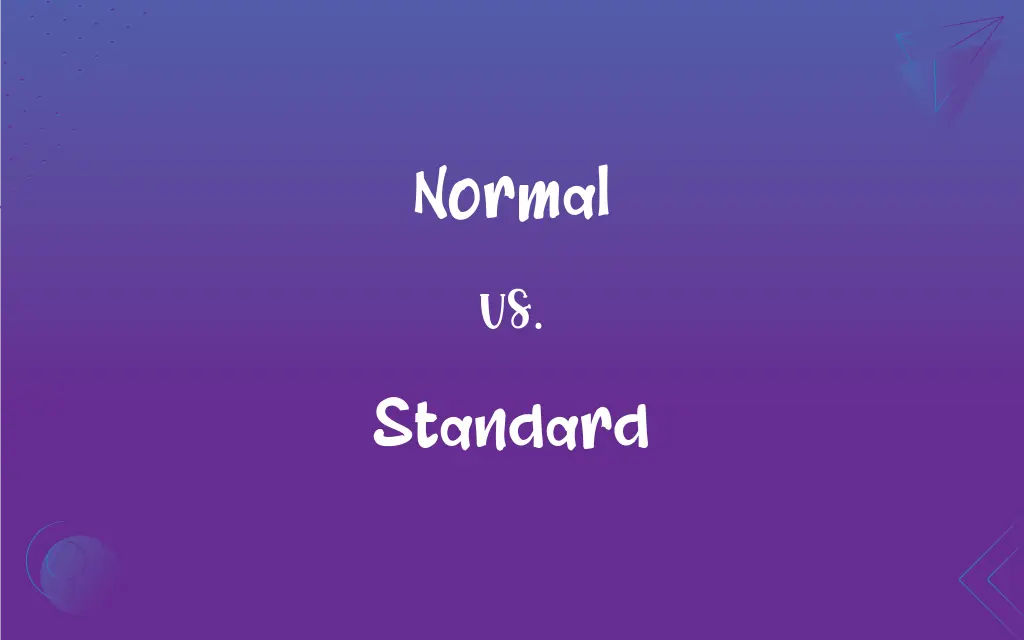Normal vs. Standard: What's the Difference?
Edited by Aimie Carlson || By Janet White || Published on January 27, 2024
"Normal" refers to what's typical or usual, while "standard" denotes an established measure or model for comparison.

Key Differences
"Normal" often implies conformity to a common or average pattern, reflecting what is typically expected in a given context. In contrast, "standard" conveys a level of quality or achievement that serves as a benchmark or reference point. Both terms set a framework for evaluating conditions or practices, but while normalcy is about what usually occurs, standards are about what should occur.
When describing behavior or conditions, "normal" is used to denote what is customary or expected in a specific environment. "Standard," however, usually refers to a predefined criterion that acts as a model or guideline. Both terms are used to assess situations but from different perspectives: normalcy is based on observation, while standards are often based on ideals or objectives.
In scientific contexts, "normal" may refer to a statistically average or common occurrence, while "standard" can denote a control or reference used for comparison. Each term plays a crucial role in research and analysis, with normal indicating what is commonly found and standard serving as a basis for measurement or evaluation.
In education, "normal" could be used to describe typical student behavior or achievement, whereas "standard" often refers to set educational goals or benchmarks. Both are integral to the educational system, with normal helping to understand student behavior and performance, and standards setting the goals and expectations.
In everyday language, "normal" is frequently subjective, varying greatly depending on social and cultural contexts. "Standard," however, tends to be more objective, reflecting a consensus or an agreed-upon norm. Both terms guide understanding and expectations, but normal is more fluid and adaptable, while standard is more fixed and universal.
ADVERTISEMENT
Comparison Chart
Definition
Typical or usual condition or behavior
Established level or model for comparison
Basis
Average or common occurrences
Agreed-upon benchmarks or norms
Context Dependence
Highly dependent on context
Relatively context-independent
Subjectivity
More subjective and variable
More objective and consistent
Role in Measurement
Reflects commonality
Serves as a reference for evaluation
ADVERTISEMENT
Normal and Standard Definitions
Normal
Conforming to a standard; usual, typical, or expected.
It's normal for toddlers to be curious about their surroundings.
Standard
A level of quality or attainment.
This car meets the highest safety standards.
Normal
Standard; not abnormal.
A normal working day for her starts at 8 AM.
Standard
Used or accepted as normal or average.
The standard rate for freelance work varies.
Normal
Free from mental disorder.
His behavior seems perfectly normal to me.
Standard
An idea or thing used as a measure, norm, or model in comparative evaluations.
Her work is the standard by which all others are judged.
Normal
Regular or ordinary.
It's just a normal part of growing up.
Standard
A rule or principle that is used as a basis for judgment.
He sets high standards for his students.
Normal
Of natural occurrence.
It's normal to feel anxious before a big test.
Standard
Authorized or recognized as best practice.
Standard operating procedures must be followed.
Normal
Conforming with, adhering to, or constituting a norm, standard, pattern, level, or type; typical
Normal room temperature.
One's normal weight.
Normal diplomatic relations.
Standard
Serving as or conforming to an established or accepted measurement or value
A standard unit of volume.
FAQs
Are standards always fixed?
Standards can evolve, but they typically change less frequently than what is considered normal.
How is "standard" used in manufacturing?
It denotes the established criteria or specifications products must meet.
Can "normal" vary between cultures?
Yes, what is considered normal can differ significantly across cultures.
Is normal always the majority?
Usually, but there can be exceptions, especially in diverse environments.
Can something be normal but not standard?
Yes, something can be common practice (normal) but not meet the established criteria (standard).
Who sets standards?
Standards are often set by authoritative bodies or through consensus.
Are standards important in education?
Yes, they provide benchmarks for assessing learning and teaching effectiveness.
Are there universal standards?
Some standards, like the International System of Units, are globally recognized.
Can standards be subjective?
While more objective than normal, some level of subjectivity can exist in how standards are applied.
What does "normal" mean in daily language?
It refers to what is usual or expected in a given situation.
Does "normal" imply something is good?
Not necessarily; it simply means typical or usual, not necessarily desirable.
Is there a "normal" in statistics?
Yes, it refers to the average or most common outcome in a data set.
Are all standards legally binding?
No, some are guidelines or best practices rather than legal requirements.
Are standards always quantifiable?
Often, but not always; some standards are qualitative.
Can "normal" have negative connotations?
Yes, if it implies conformity or discourages individuality or progress.
Can normal be a personal feeling?
Yes, individuals can have their own sense of what's normal for them.
Do standards require enforcement?
In many contexts, yes, to ensure compliance and consistency.
Can something be standard but not normal?
Yes, especially if it's an ideal or goal that's not yet commonly achieved.
How is "normal" used in psychology?
It often refers to behavior or processes typical for an individual or group.
Does "normal" change over time?
Yes, what is considered normal can evolve with societal changes.
About Author
Written by
Janet WhiteJanet White has been an esteemed writer and blogger for Difference Wiki. Holding a Master's degree in Science and Medical Journalism from the prestigious Boston University, she has consistently demonstrated her expertise and passion for her field. When she's not immersed in her work, Janet relishes her time exercising, delving into a good book, and cherishing moments with friends and family.
Edited by
Aimie CarlsonAimie Carlson, holding a master's degree in English literature, is a fervent English language enthusiast. She lends her writing talents to Difference Wiki, a prominent website that specializes in comparisons, offering readers insightful analyses that both captivate and inform.































































